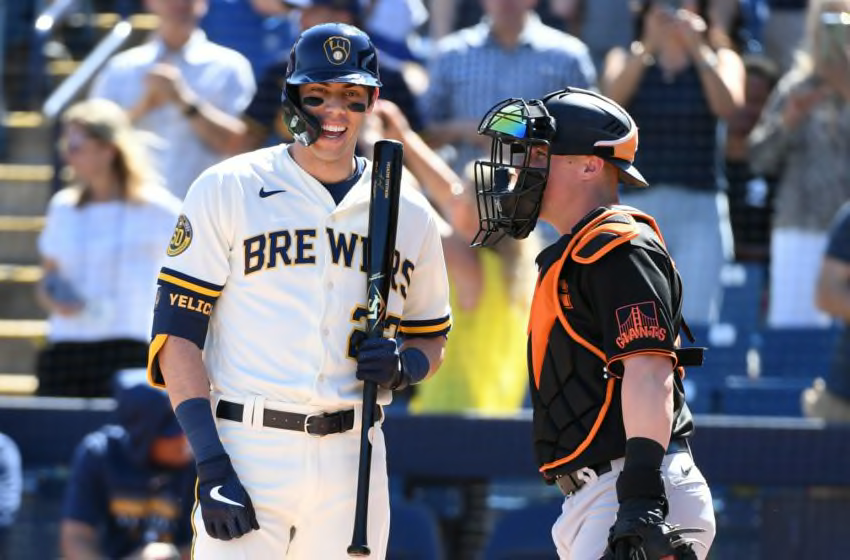
MARYVALE, ARIZONA – MARCH 06: Christian Yelich #22 of the Milwaukee Brewers talks with catcher Tyler Heineman #81 of the San Francisco Giants prior to stepping into the batters box during a spring training game at American Family Fields of Phoenix on March 06, 2020 in Maryvale, Arizona. (Photo by Norm Hall/Getty Images)
The Milwaukee Brewers over-performed their run differential last year and lost some key pieces in free agency. Can they get back to the postseason in 2020?
Were the Milwaukee Brewers lucky to make the playoffs last season?
If run differential is any indication, Milwaukee had no business even being in position to lose to the eventual World Series champion Washington Nationals in brutal fashion in last year’s National League Wild Card game. The Brewers scored 769 regular season runs and allowed 766, an 81-81 projected record if you look at the Pythagorean win percentage, worse than three teams that missed out on the NL postseason.
The two main factors that got the Brew-Crew into the playoffs last season? A 20-7 record in September and a 27-18 mark in one-run games. Going 15-4 against a Pittsburgh Pirates team that needs to rebuild right now didn’t hurt either.
So Milwaukee definitely had to go out in the offseason and improve a team that probably should’ve gone .500 last year, right? As Lee Corso would say, not so fast, my friend.
If we’re going by FanGraphs‘ measure of WAR, the Brewers lost three of their top six hitters from last season. Catcher Yasmani Grandal parlayed his 28-homer 2019 season into a four-year, $73 million deal with the Chicago White Sox, the largest free agent contract in team history. Mike Moustakas declined his side of an $11 million mutual option and took his 35 dingers on to Cincinnati. Eric Thames and his 25 jacks are now with Washington after his $7.5 million club option was declined.
On the pitching side, though the Brewers finished 16th in ERA, they were 9th in strikeouts and 10th in opponent batting average. They lost Zach Davies, Gio Gonzalez, Chase Anderson, Jordan Lyles and Drew Pomeranz, five of the team’s top nine pitchers in WAR, though the latter two were each less than one win above replacement.
The plan to replace a lot of these players on large contracts centered around trades and short-term signings to lower the short- and long-term payroll from $135.9 million in 2019 to an estimated $95.3 million in 2020 according to Spotrac, though with a shortened season this year, who really knows how much the prorated tab will end up being?
To replace Moustakas, Milwaukee sent Davies and Grisham to San Diego for young infielder Luis Urias and 24-year-old starter Eric Lauer, whose ERA was a little worse than league average but whose WAR would’ve ranked third on the team. The Brewers hope that pairing Urias with top infield prospect Keston Hiura will give them a strong double-play combo for years to come.
To replace Grandal at catcher, Milwaukee traded a minor leaguer and a Round B competitive balance draft pick to Seattle for Omar Narvaez, who shattered career bests last season with 22 homers and 55 RBIs and is under team control for three more seasons. The Crew is betting the 28-year-old’s 2019 campaign was far from an aberration.
Thames’ playing time will likely be taken by some combination of Justin Smoak and Ryon Healy, who each inked one-year deals for a combined $6 million. Eric Sogard, Brock Holt and Jedd Gyorko all signed one-year pacts for a combined $9.75 million to provide infield depth.
Milwaukee only gave multi-year deals to two free agents over the winter. After a strong make-good year with Tampa Bay, outfielder Avisail Garcia got two years and $20 million. And after an MVP season with the KBO, pitcher Josh Lindblom got $9.125 million for three years. The Brewers finished their shopping at the discount aisle by re-signing reliever Alex Claudio for one season despite a slightly negative 2019 WAR and inking the flamethrowing, oft-injured righty reliever David Phelps to a one-year deal.
Though Milwaukee should definitely be credited for giving Christian Yellich a seven-year, $188.5 million extension, the team needs these short-term contracts to come up big and provide the lost offense that guided the Brewers to the 2019 postseason.
Preseason PECOTA projections from Baseball Prospectus put Milwaukee at 79-83 and a fourth-place finish in the N.L. Central, though an 82-game season playing different opponents with a universal DH adds variables. But there’s no question that the Brewers’ $40 million payroll cut makes them worse this season. And given how slim their margins were last season in reaching the postseason, a regression in 2020 should be expected.